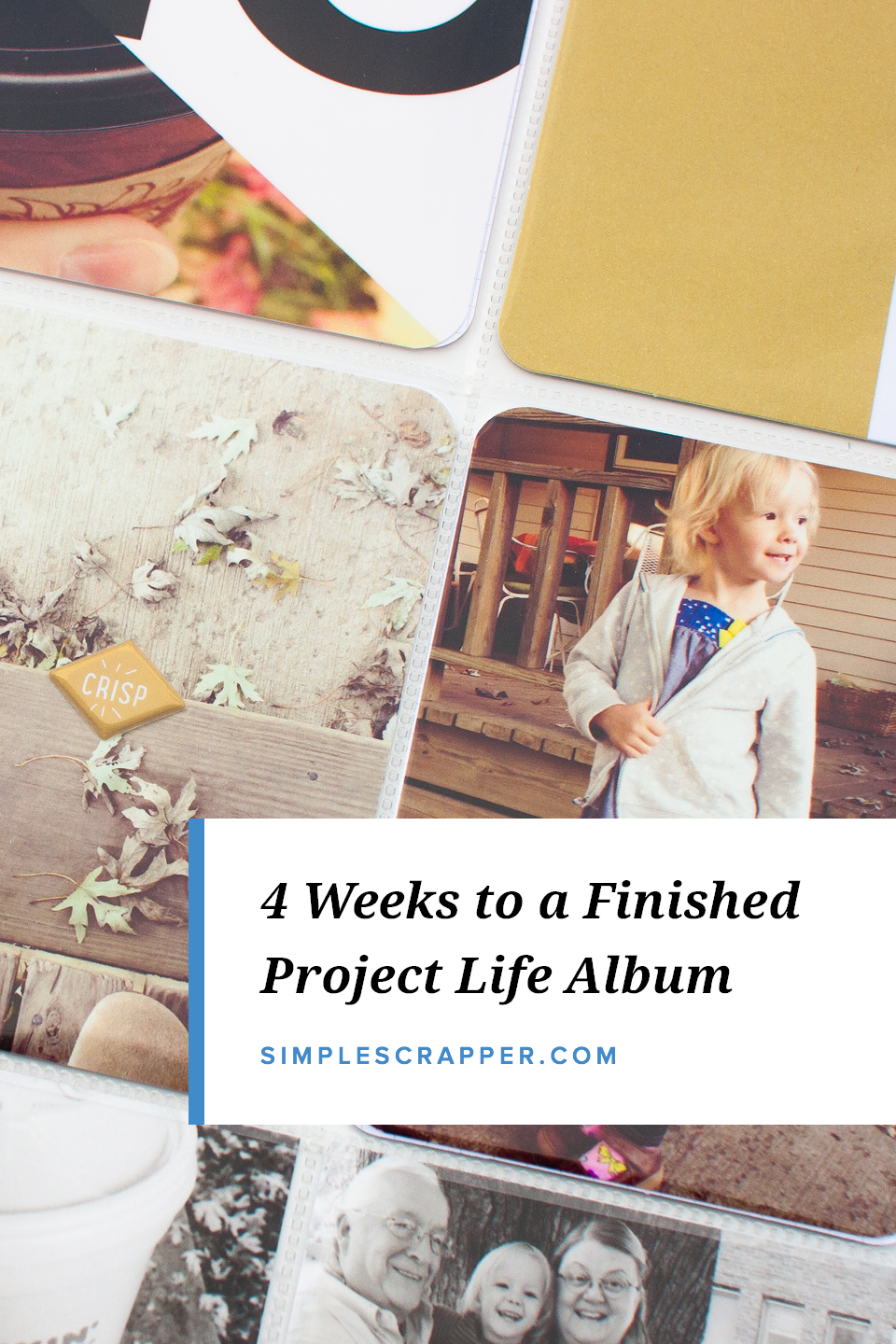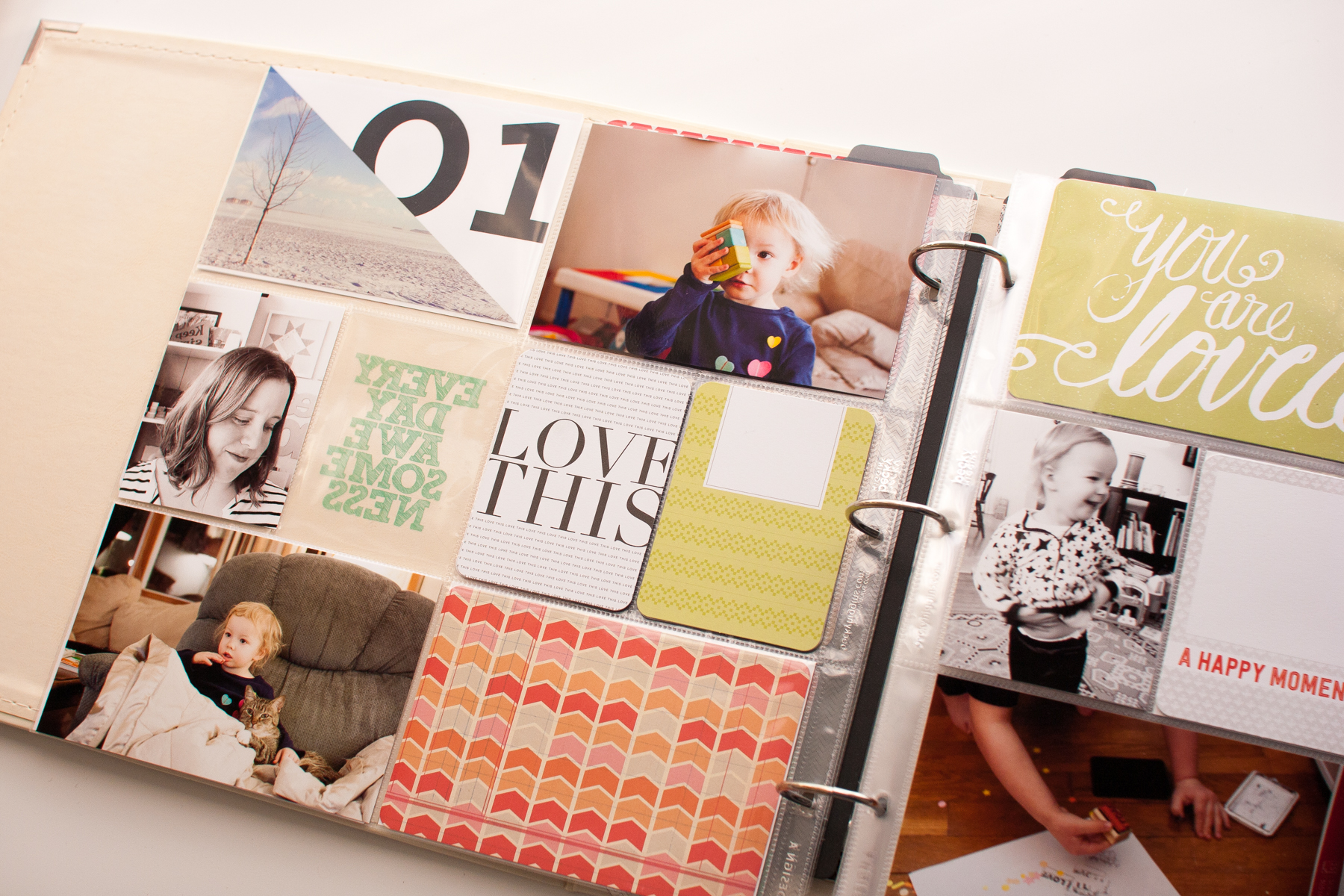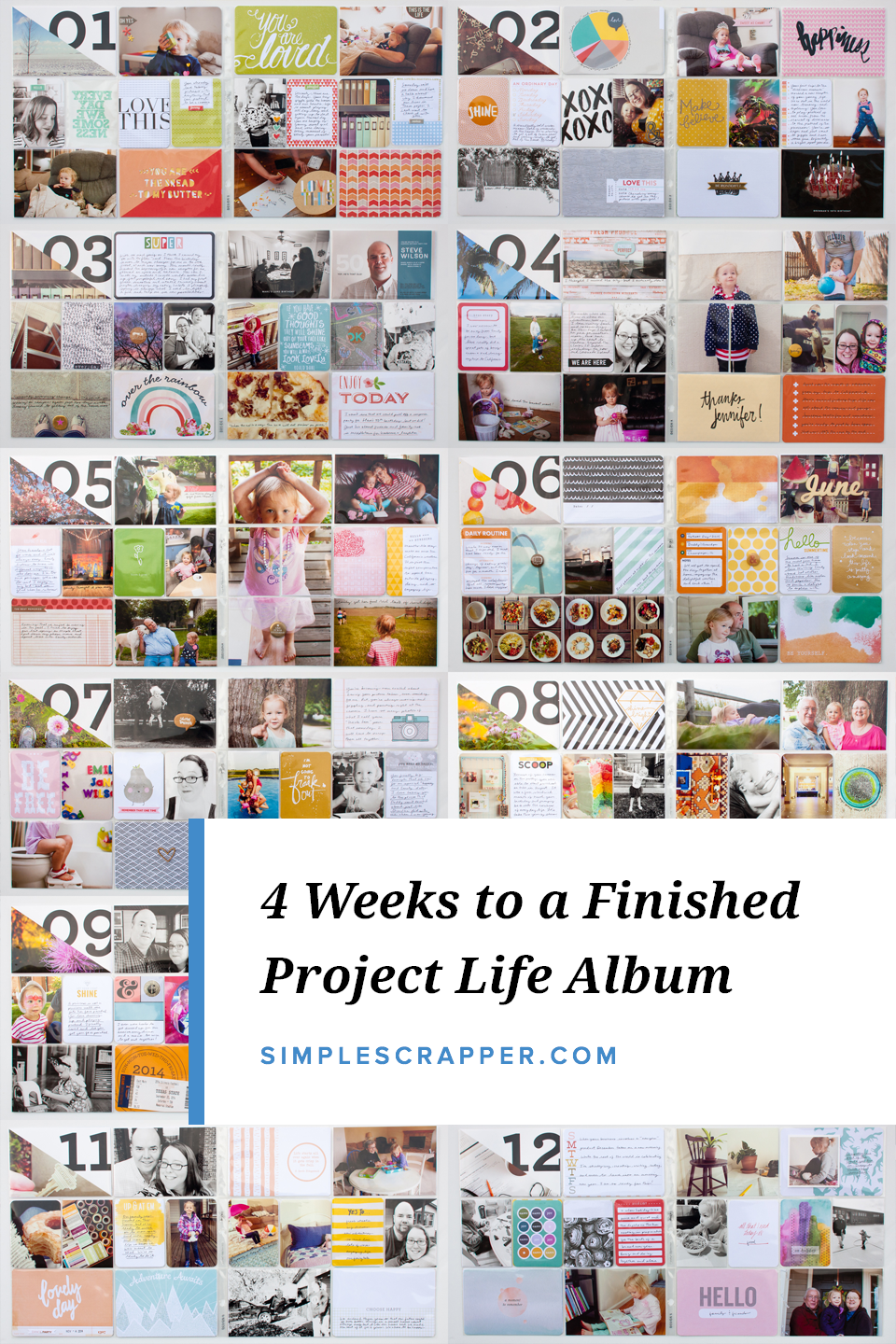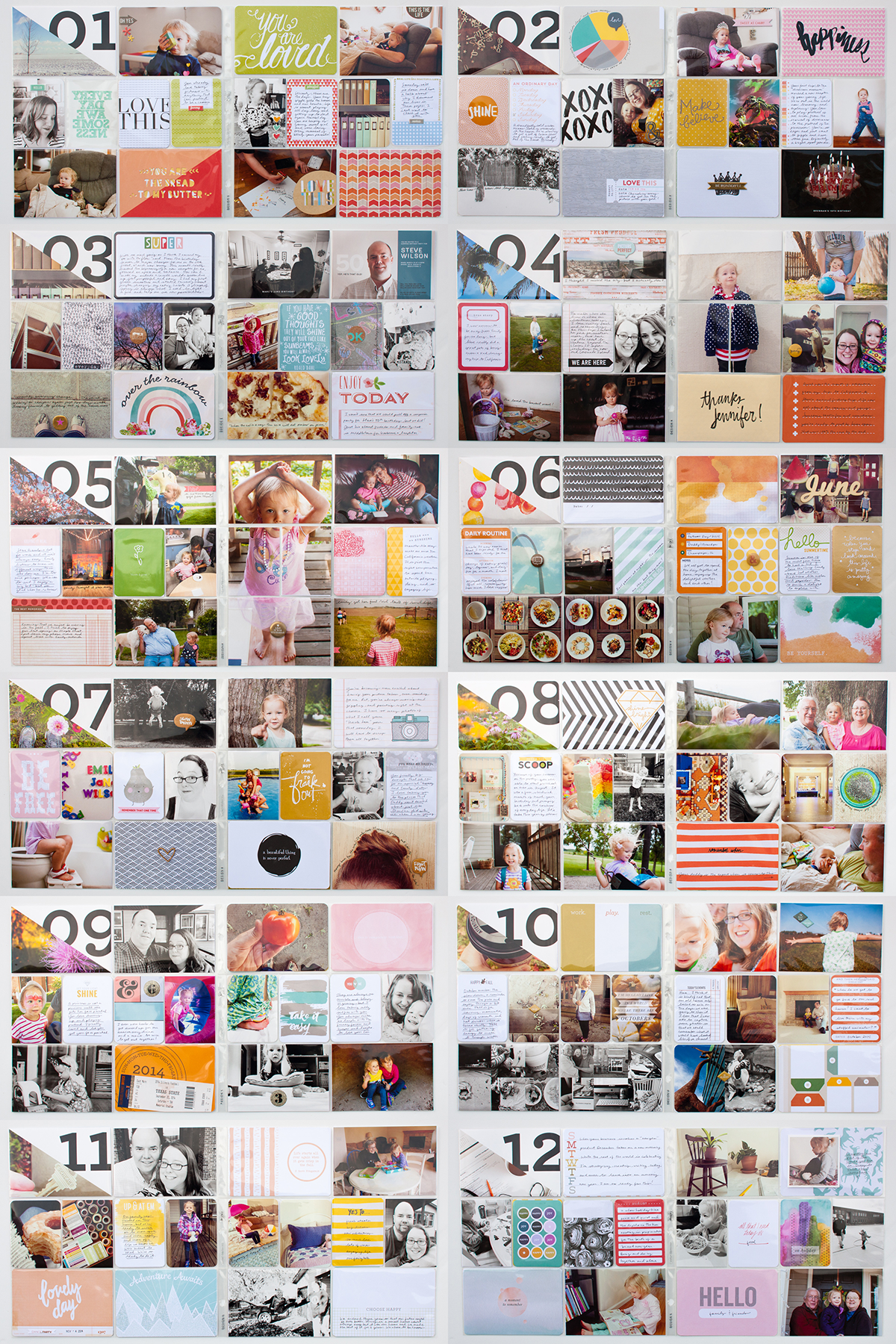The corners of your mouth slope upward.
Your eyes light up with a special sparkle.
You feel warmth and true contentment.
There are many things that bring me this sense of deep happiness, and one of them is undoubtedly finishing a project.
The thing is, it doesn’t come naturally for me to work on something just a little bit at a time over a long period until it’s finished. While I am trying to improve my habit-forming skills, what I’m better at is short-term focus.
That means my projects are often completed in shorter, more-intensive bursts. I’m OK with that because done is done regardless of how you got there!
At the beginning of 2015 I had bits and pieces of my 2014 Project Life pages completed, but it was far from complete. In this post I’m sharing the strategy I used to complete all of my pages in less than a month.

How I Approach Project Life
Before I share the step-by-step, I need to back up a bit. Finishing actually begins with starting and specifically, how you start a project. (Hint: It doesn’t start with shopping!)
I’ve never attempted a weekly Project Life album because I knew I’d never be able to keep up. I’m not the most prolific scrapbooker, and as someone who does enjoy storytelling with layouts I certainly wasn’t going to create two albums for a year! I had to craft my own simplified approach.
I combine monthly Project Life spreads in one annual album with layouts, memorabilia, and other pocket page inserts. So instead of 52 pocket page spreads, my albums have just 12 plus a handful of others for holidays or trips. All of this together is sustainable for my lifestyle and neatly fits in one single album.
So completing my 2014 Project Life meant creating 12 spreads from photos to finishing touches. And by simplifying the project before I began, it became that much more “finishable”.
Now please don’t get discouraged; the process I’m sharing below can be followed even if you’re already in the thick of a bigger Project Life album. There’s still time to make course corrections and utilize productivity tricks to get it done!
How I Finished in Less Than 4 Weeks
The secret to this finishing success was batch processing. Instead of completing one spread at a time, I completed each individual step in the process for all the spreads at once.
I estimate that I devoted just 3 hours per week to the process, reducing the time I would have spent by at least half! Here’s how:
Step #1 – Organize Photos (1 hour)
Using Lightroom, I sorted my 2014 photos into month folders so that I could see the pool from which to select images. Whether you’re using software or simply folders, basic organization makes the process so much easier.
Step #2 – Select and Edit Photos (3 hours)
My goal was to select 8-10 images per 16-pocket spread. Selected photos were identified in Lightroom with a star rating. Vertical photos were cropped to 3×4 and horizontal photos to 4×6. iPhone photos were often edited using a black & white recipe in RadLab. Exposure and contrast were touched up on DSLR photos with Lightroom.
Step #3 – Print and Insert Photos (2 hours)
I printed all of my photos at home in several sittings and then inserted them in pockets. If you mail order or print at a local photo center, this is where batch work really comes in handy. You’ll only need to print your project photos once!
Step #4 – Add Blank Journaling Cards (1 hour)
With the photos in place I added Project Life cards to the remaining spots, creating a foundational design. I used both cards with journaling areas and filler cards with words or graphics. To visually balance the page, sometimes a few photos moved around.
Step #5 – Add Embellishments (2 hours)
My embellishing was kept fairly minimal, emphasizing small chipboard pieces and word stickers that related to the stories represented on the page. I look at my spreads as a collective story of this month rather than individual stories.
Step #6 – Add Journaling (3 hours)
I journaled on top of photos with a Slick Writer or on journaling cards with a extra fine point Precision Pen. My journaling approach is to combine facts, feelings, and memories. I don’t worry about capturing absolutely everything, but instead focus on documenting my reflections and the meaning behind it all.
If you’re like me and have trouble working on big projects a tiny bit at a time, a simplified approach coupled with intensive bursts might be the most satisfying choice you make this year.
What project could you finish with this batch approach?





I’m wondering if I could get my son’s school album up to date. I’m working on a double page LO per school year plus one or two extra LOs for special events.
You would probably do 2-3 double-page layouts at once using this batching approach, especially if you have a big table. Otherwise, you might simply find it helpful to create micro kits for each page that include the photos and then work on the pages one at a time.
Thanks Jennifer!
I am using this approach for 2016. Using Simple Stories Year in Review collection I have already set up my entire 2016 album with 3×4 and 4×6 and some 3×3 and 2×2 cards.The collection came with all the journaling cards, page protectors and epherema. Took me a good 5 hrs to set it up. Done!
At the end of each month I add the pics. So far I am up to date. I’ve added a couple 12×12 LO’s for Jan and Mar too.
I tried the kit club way getting a kit each month but I was overwhelmed with product choice and never finished one complete year on time.
Fantastic Shannon! You’ve simplified your approach and have a system for getting it all done.
This is fine if you are doing that kind of project but how to adapt it to creating individual pages? More time is spent creating and tweaking than when using pocket pages.
You can certainly leverage batching for layouts! I like to print 6-10 photos for a group of layouts, create micro kits that combine photos with card stock and supplies for just that page, trim papers and arrange the foundational design, adhere everything, add embellishments, add journaling. The limitation is more the size of your table, but it can be a fun and efficient way to work. I don’t do that all the time, but it’s proven that your brain really prefers it when like tasks are grouped together.
You may want to consider http://www.clubscrap.com and their ALSB approach. It’s a brilliant way to batch pages.
I’ve never considered a batch approach – sounds like a great way to go back and be able to complete an unfinished album. Will have to consider this for my daughter’s school album. I have Pre-K through 7th grade done, got stuck on 8th grade (she’s 25 now!) Thanks for the great blog post, Jennifer!
This is definitely the perfect starting point for getting caught up on that album.
I performed this process when I had 4 vacations to scrap for 1 year. By pre-planning my album prior to each trip, I only had to add the photos and journaling and add some small tweaks to my pre-made layouts. The largest album was about my cruise and subsequent island hopping and it took the longest to complete – 1 week.
Great post and idea for me to use going forward!
You know I LOVE planning. The simple act of thinking through a project from start to finish helps eliminate future roadblocks and ensure smooth sailing to the finish!
I’m in the midst of completing my 2014 album too – and I love the idea of scaling back to one spread per month. Might have to adjust my approach here since I lost a huge batch of photos in a lost iphone (pre-cloud days). The weekly approach just seems like overkill. Thanks Jennifer!
Could you “outsource” a selection of photos from that time with images from friends and family, plus supplement with relevant screenshots?
I just did some special layouts of a visit to a conservatory (so many flower photos!) using Lea France stencils. This approach would help me finish the trip more quickly and efficiently! And there are other similar trips from other years, a conference DH takes me along most years, and then the photos just sit there waiting.
I love how my overall album approach gives me time to do more involved, special layouts along with some pages that are more minimal and easier to create.
This is so great. I am actually about halfway through my December daily and have about 20 weeks of 2015 PL unfinished. I can sort and group photos at night while watching television, so that would help keep me from feeling like I would be in my Craftice all night every night, chained to the PL album. lol. I have thought of giving it up, as I am already behind for 2016! But if I went to once a month, that might feel better.
That’s sounds like a great idea. Celebrate the 20 weeks you do have done and then simplify to round out the rest of the year. You’ll be glad it’s finished.
Love this approach and plan to use it to finish up some PL albums from past years. It looks like you just use one style of page protectors to simplify the process – is that correct? Do you use other type of page protectors in other parts of your albums (trips, vacations, etc)?
I tend to use one style as my base, but I do switch it up elsewhere in the album with different sizes and configurations. For trips I’ll often do 6×12 or a grid of squares.
What collection did you use for cards? Love your style and process. Thank you for the post!!
Thanks Kady! I primarily used cards from the Studio Calico Project Life (now called Documenter) kits.
You have articulated and broken down a process I have used over the years to approach big projects in a manageable time period. I used to create spreadsheets and then would chart my progress giving me lots of joy on all levels.
I just completed a big project using this method and am now ready to undertake a project I have been putting off for 9 years. Thank you! Excellent piece.
<3 spreadsheets for all.the.things
I love the triangular title cards for each month. How did you do that? Really looks great!
Thanks, I created them myself! You can download here as layered PSD files in a zip: https://s3.amazonaws.com/freebie-downloads/ss_freebie_2.07.zip
Thank you for the download, Jennifer!!! That was very nice of you! 🙂
Super cool. Thanks!
Although I have my ‘project’ life organized for 2016, I am always curious about other approaches to organizing most anything so I signed up for the class too for an in depth look. Going to read it tonight! Thanks for all your tips and processes.
I think this will work for our road trip family reunion album. I wanted to do a page for each state we were in, but just organizing the pics seem overwhelming. Your ideas here should help me get it done! Sheila
I’m trying to complete an album that includes photos from 2007-2009, and I do want to make it up to 2014 even. It is a family memories album, I am doing the monthly approach and I mainly have many photos in collages. What I am trying to do right now is complete the journalling, I don’t remember well what happened as back then I did right a journal or keep notes of what happened in each event, I am going by memory and the photos help me. I don’t have all the photos/collages printed as I can’t afford it right now, I do hope to print at home in the future. What I want to do for the unprinted ones is still get some journalling cards and write down what happened, at least then the journalling is complete. Do you have any tips at all?
With journaling cards, I focus on 2-3 sentences that share a fact, a feeling, and a related memory. This allows you to reflect from the present day without having to remember details. Focus on why this memory matters.
Would you please share what printer you use?
I’ve used an Epson PictureMate and would recommend the newest version for a 4×6 printer. Today I mostly use a Canon PRO-100 large format printer.
When you say your vertical photos were cropped to 3×4, do you print 4×6 and then crop them after printing?
I crop prior to printing. I will often print them as two 3x4s on a 4×6. I do this with Lightroom, but you can use a template in Photoshop, and many printer softwares will do this. There are even phone apps (PicFrame is one) that can collage two photos together.
I’m patting myself on the back as this is the approach I already use! However I think you’ve made it even simpler by using only 4×6 horizontal photos and 3×4 vertical. I tend to take way more vertical photos but could still use your method with the opposite layouts as this would prevent the problem of not having the right sized photos for the backs of the pages! Great tip – thank you for sharing!
Hi, there, Jennifer! I was wondering what font did you use for the beautiful numbered month cards. I’m thinking doing it for all the 52 weeks of 2017. Thank you, by the way!
I have a free template for those cards on this page: https://www.simplescrapper.com/free-downloads/
Thank you! I’ve got it, already. But I was wondering about doing it weekly, instead of monthly. Well, thanks again. You are such an inspiration!
Ah, I see. I believe the font was Archer, but you might find similar results with Museo Slab. I like fontsquirrel.com as a good place for free professional fonts.